The NEC PC-H98 (or HYPER98) is a long forgotten MS-DOS workstation from 1990 or so, and based on the unknown in the west (but big in Japan) PC-9801 architecture. Specifically it has two modes, one that allows it to run PC-9801 software (normal mode) and one that allows it to run high-resolution software for the PC-98XA, XL, RL, and A-Mate models (that featured an expansion card for high-res video). A good way of describing the H98 is it's somewhat like the IBM PS/2: it featured unique ports and a brand new expansion bus (NESA) alongside the original bus (in this case C-Bus).
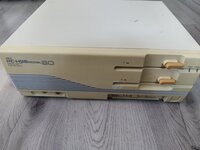
Mine is a Model 80 (an 80486 based model), which features a 16mhz 486. I wanted to get this up and running however there was one problem. The video cable information is undocumented outside of obscure Japanese web pages, and even then there isn't much information on what connector this machine needs. This seems unusual, until you take a look at the motherboard and notice a bizarre connector: a mix of a mini Centronics connector and 3 "video" pins from 13w3, except they're smaller than 13w3 pins. This was done for the same reason the Power Mac x100 models featured a weird connector as well, as the keyboard/sound/power switch were passed through the monitor cable too.
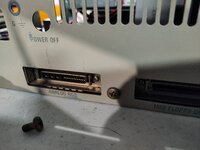
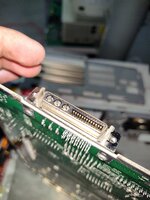
The connector has many nicknames including 26w3, composite 29 pin (or 複合29ピン), and is notorious even in Japan for being hard to get. To quote one site via Google Translate on saying why to explicitly avoid the H98 series:
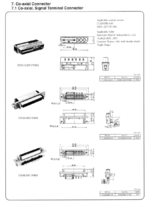
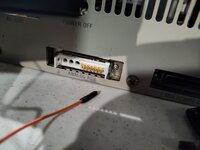
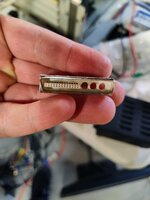
The next step was to wire this up. To get non interlaced high-res video and 30khz normal-res video, also bridge pins 10, 11, and 12 to ground (the shield works). For reference, the full pinout can be found here and the resolution jumpers here. Notice the position of the 3 coax pins, they are ordered RBG instead of RGB. There are two staggered rows, the top row is pins 1-13 and the bottom row is 14-26.

The most important thing is to wire up VGA Pin 10 to H98 pins 2 and 4. This has to be done, otherwise the video will not be synced properly and you will get an out of range error or rolling display. The other problem was wiring up the RGB wires, I ended up gluing the wires into the connector and reusing a junk VGA cable as it presumably wants some weird coax setup but inserting in the wires so it touches the coax pins works fine. It's not something I'd recommend for long term use though.
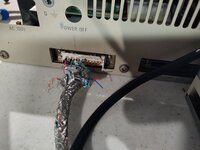
The end result? A PC-H98 saved from the junk pile.
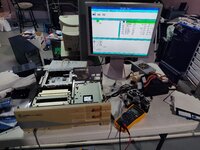

Mine is a Model 80 (an 80486 based model), which features a 16mhz 486. I wanted to get this up and running however there was one problem. The video cable information is undocumented outside of obscure Japanese web pages, and even then there isn't much information on what connector this machine needs. This seems unusual, until you take a look at the motherboard and notice a bizarre connector: a mix of a mini Centronics connector and 3 "video" pins from 13w3, except they're smaller than 13w3 pins. This was done for the same reason the Power Mac x100 models featured a weird connector as well, as the keyboard/sound/power switch were passed through the monitor cable too.


The connector has many nicknames including 26w3, composite 29 pin (or 複合29ピン), and is notorious even in Japan for being hard to get. To quote one site via Google Translate on saying why to explicitly avoid the H98 series:
With the lack of a video cable being the main issue preventing this from being a useful computer, I decided to build my own. At first I was planning on removing the motherboard and soldering pins to it, but after a friend of mine sent me a link to an obscure Japanese website, I found out everything you need to build a video cable for this thing. The first thing you need is the DX30AJ-26P-CP3(50) (from Digikey) connector. This is a Hirose DX series connector. The connector lacks the 3 coaxial styled pins, which go by part number MJ-P-1.5CV(P)(40) and can be found on Mouser. I ordered the connector and confirmed: it fit.So far, it seems to be convenient for games, but the reason why I can not recommend it is that the analog RGB connector connected to the monitor is special (composite 29 pin) and a conversion cable ("PC-H98-K04", NANAO P4A "MD" -C67 "is famous) is not available. For the time being, you can buy the connection cable at Tansei Tsusho , so you can make your own conversion cable. By the way, please note that in high resolution mode, screen modes such as interlaced and non-interlaced are switched with the reserved pin.



The next step was to wire this up. To get non interlaced high-res video and 30khz normal-res video, also bridge pins 10, 11, and 12 to ground (the shield works). For reference, the full pinout can be found here and the resolution jumpers here. Notice the position of the 3 coax pins, they are ordered RBG instead of RGB. There are two staggered rows, the top row is pins 1-13 and the bottom row is 14-26.
| Pin Description | VGA | PC-H98 |
| Red | 1 | A1 |
| Green | 2 | A3 |
| Blue | 3 | A2 |
| Red Gnd | 6 | A1 Shield |
| Green Gnd | 7 | A3 Shield |
| Blue Gnd | 8 | A2 Shield |
| H-Sync | 13 | 1 |
| H-Sync Gnd | 10 | 2 (CONNECT TO VGA PIN 10 ALONG WITH 4!) |
| V-Sync | 14 | 3 |
| V-Sync Gnd | 10 | 4 (CONNECT TO VGA PIN 10 ALONG WITH 2!) |
The most important thing is to wire up VGA Pin 10 to H98 pins 2 and 4. This has to be done, otherwise the video will not be synced properly and you will get an out of range error or rolling display. The other problem was wiring up the RGB wires, I ended up gluing the wires into the connector and reusing a junk VGA cable as it presumably wants some weird coax setup but inserting in the wires so it touches the coax pins works fine. It's not something I'd recommend for long term use though.

The end result? A PC-H98 saved from the junk pile.

